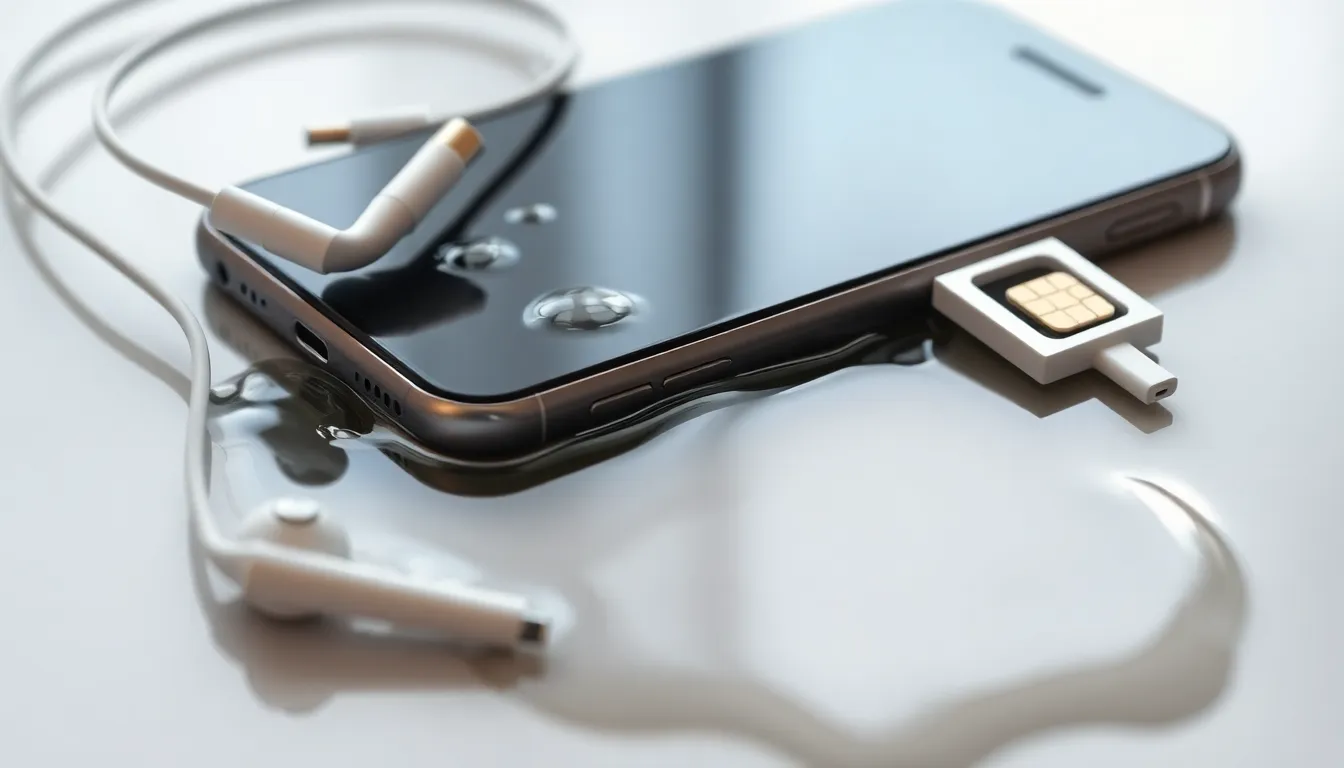Water and iPhones don’t mix, but accidents happen. Whether it’s a splash from a drink or an unexpected dive into the pool, a waterlogged iPhone can send anyone into a mini panic. Fear not—there’s hope! With a few clever tricks, you can rescue your beloved device and save it from an untimely demise.
Table of Contents
ToggleUnderstanding Water Damage in iPhones
Water damage poses significant risks to iPhones, affecting their internal components and overall functionality. Spills and submersion present common scenarios that lead to this damage. Liquid exposure can corrode crucial parts like the circuit board and battery, leading to short-circuiting.
Apple’s built-in Liquid Contact Indicators (LCIs) detect moisture exposure. LCIs change color when activated by water, allowing users to identify water damage. Activation of an LCI signals that professional assessment is necessary. Once a phone experiences water exposure, swift action can prevent further damage.
Limitations exist regarding water resistance in iPhones. Many models have an IP68 rating, showcasing resistance to water up to 6 meters for 30 minutes. However, this resistance doesn’t ensure complete protection against water damage. Prolonged exposure or high-pressure water scenarios can compromise this capability.
Symptoms of water damage can manifest in multiple ways. Sudden screen malfunctions or unresponsive buttons often indicate liquid issues. Additionally, persistent issues with charging ports or speaker quality may arise due to moisture intrusion. Users should prioritize quick drying and immediate troubleshooting.
Emergency steps to mitigate water damage include turning off the device promptly. Removing the SIM card and external accessories assists airflow. Positioning the phone in a dry area with minimal humidity aids in the drying process. Utilizing silica gel packets or rice can help absorb residual moisture effectively.
Immediate Steps to Take When Your iPhone Gets Wet

Immediate actions are crucial when an iPhone gets wet. Quick responses can minimize damage and improve recovery chances.
Turn Off Your iPhone
Turning off the iPhone prevents electrical short-circuiting. Water exposure increases the risk of damage to internal components, so powering down is essential. If the device is still operational, pressing and holding the side button and either volume button until the “slide to power off” prompt appears suffices. This action halts all functions, reducing energy running through the circuitry. Don’t hesitate, as even a few moments of operation can lead to further complications.
Remove Accessories and SIM Card
Removing accessories is vital to facilitate drying. Unplug headphones, cases, and chargers to eliminate moisture traps. Additionally, take out the SIM card to reduce the likelihood of damage to the card and the tray. This step creates space for airflow, enhancing the drying process. Using a small tool, open the SIM tray, and gently set it aside in a dry area. Every accessory removed accelerates the overall drying time for the iPhone.
Effective Methods to Clear Water from iPhone
Immediate action helps minimize water damage to an iPhone. Utilizing effective methods increases the chances of recovery.
Using Absorbent Materials
Paper towels or microfiber cloths work well for soaking up moisture. Gently blotting the device with these materials prevents the risk of pushing water deeper into its components. It’s essential not to rub the iPhone, as this action may spread water to vulnerable areas like buttons or ports. Removing moisture from the exterior also ensures better airflow for drying. Placing the phone upside down on a flat surface allows residual water to escape the openings. Drying with absorbent materials remains a simple yet effective step in the recovery process.
Employing Compression Techniques
Using a vacuum cleaner can assist in extracting water from the iPhone. The suction pulls moisture out without direct contact, minimizing the risk of further damage. Positioning the phone near the vacuum nozzle, but not touching it, enhances effectiveness. Holding the vacuum at different angles lets air reach all parts of the device, targeting sensitive areas like speaker and charging ports. To maximize results, running the vacuum for several minutes may draw out trapped moisture. This method offers a quick solution when combined with immediate drying actions.
Prevention Tips for Avoiding Water Damage
Taking precautions can significantly reduce the risk of water damage to an iPhone. Using protective accessories plays a crucial role in this effort.
Use of Water-Resistant Cases
Water-resistant cases offer an excellent layer of protection. These cases prevent water from seeping into the device during spills or rainy conditions. Many options on the market provide varying degrees of water resistance, often rated by IP standards. A case with an IP68 rating can guard against submersion in water, so selecting one that fits the iPhone model is wise. It’s important to check seal integrity regularly to ensure maximum protection. Users also benefit from added shock resistance while using these cases, providing dual protection against physical impacts and moisture.
Maintaining Careful Usage
Maintaining careful usage of the iPhone helps avoid accidental exposure to water. Being mindful of the device around liquids is essential, particularly during activities like cooking or dining. Keeping the phone away from pools, beaches, or other water bodies reduces risk. Users should also consider using pouches or holsters during outdoor activities where the chance of moisture exposure increases. Regularly checking for signs of wear on any protective accessories ensures that the device remains safeguarded. By implementing these strategies, individuals significantly diminish the likelihood of water-related issues.
Taking immediate action when an iPhone gets wet can make a significant difference in recovery outcomes. By powering off the device and removing accessories, users can minimize the risk of electrical damage. Employing techniques like gentle blotting and vacuum extraction helps in effectively clearing water from the device.
Prevention is equally important. Utilizing water-resistant cases and maintaining careful handling around liquids can reduce the chances of future incidents. By following these strategies, users can protect their iPhones and increase the likelihood of a successful recovery from water exposure.


